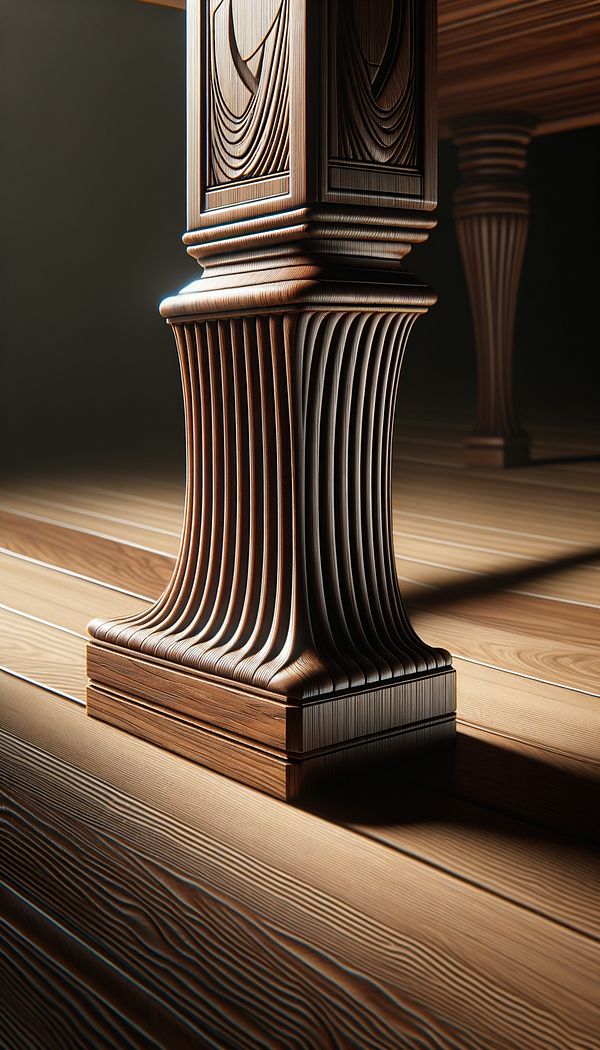What is Reeding?
Reeding is a decorative technique involving narrow grooves carved into the surface of wood, metal, or stone.
Description
Reeding is a historical decorative technique that dates back to classical architecture, where it was prominently used in columns and furniture details. This design feature comprises a series of narrow, parallel grooves carved into the surface of wood, metal, or stone. The purpose of reeding is purely decorative, adding texture and visual interest to what might otherwise be a flat, unadorned surface.
In interior design, reeding is often found on the edges of furniture, woodwork around doors and windows, and even in finer details such as lamp bases and silverware handles. Its presence can evoke a sense of classical elegance or a subtle hint of detail in a minimalist design scheme. When used judiciously, reeded elements can harmonize with a wide range of interior styles, from traditional to contemporary.
The visual effect of reeding is to create a play of light and shadow on the surface, which can make the material appear more refined and intricate. This technique is particularly effective in materials that naturally reflect light, such as polished wood or metal, where the reeded grooves can enhance the material's natural beauty.
Usage
Reeding is commonly used in the design of high-end furniture, including table legs, cabinet doors, and bed posts. It is also utilized in the creation of architectural trim work, such as around door frames and windows, or in the detailing of wood paneling. In addition to wood, reeding is occasionally found on metal objects like silverware and light fixtures, where it adds an extra dimension of texture and sophistication.
FAQs
-
Is reeding used exclusively with wood?
No, while wood is the most common material for reeding, it can also be applied to metal, stone, and occasionally plastic, to achieve a similar decorative effect.
-
Can reeding be combined with other decorative techniques?
Yes, reeding can be used in combination with other decorative techniques such as fluting, carving, and ormolu to create intricate and detailed designs.
-
Does reeding have any structural benefits?
No, reeding is primarily a decorative technique and does not offer structural benefits. Its main purpose is to add visual interest and texture to surfaces.
-
How does reeding differ from fluting?
Reeding and fluting are similar in that both involve the carving of grooves into a surface. The main difference is that reeding consists of raised strips (the grooves are concave), whereas fluting involves the carving of convex grooves, creating a series of ridges.
-
Can reeding be used in modern interior designs?
Yes, while reeding is often associated with classical and traditional designs, it can be effectively incorporated into modern and contemporary interiors as a detail to add texture and interest.
Practical Application
When incorporating reeding into your interior design, it's important to consider the overall style of the space and how the reeded elements will complement it. Reeding can add a touch of elegance and complexity to furniture and architectural details, so use it strategically to enhance, rather than overwhelm, your design. For a cohesive look, consider matching the material and finish of reeded elements with other decorative features in the room.
-
Architectural Elements199 articles
-
Furniture Types599 articles
-
Decorative Techniques322 articles
-
Materials & Textiles360 articles
-
Wall Treatments & Finishes157 articles
-
GildingGilding is the application of a thin layer of gold or gold-like material to a surface.
-
CanterburyA Canterbury is a type of portable, open-topped furniture designed to hold sheet music or books.
-
Queen AnneAn architectural and furniture design style that originated in the late 17th and early 18th centuries, characterized by its elegant and ornate features.
-
BookcaseA piece of furniture equipped with shelves, used for storing and displaying books.
-
BoiserieBoiserie is a French term that refers to intricately carved wood paneling used for walls.
